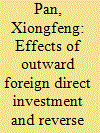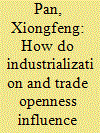| Srl | Item |
| 1 |
ID:
175007


|
|
|
|
|
| Summary/Abstract |
Under the background of substantial outward foreign direct investment (OFDI) from China to other countries, it is of great practical significance to examine whether OFDI of China brings green spillovers towards the home country. In view of the lack of in-depth research on the effect of reverse technology spillovers of OFDI on China's carbon productivity, this paper attempts to fill the research gap. Based on a panel dataset involving 30 provinces, this paper calculated the provincial total factor carbon productivity (TFCP) for the period of 2004–2016, and used the Spatial Durbin Model (SDM) to examine the effect of reverse technology spillovers of OFDI on TFCP. The results show that reverse technology spillovers of China's OFDI can significantly promote the growth of TFCP, and the reverse technology spillovers of OFDI has a positive effect on the improvement of TFCP by promoting the technological capabilities of the region. The reverse technology spillovers of OFDI can increase the TFCP of neighboring provinces through the spatial spillover mechanism. Additionally, there exists regional heterogeneity in the effects of the reverse technology spillovers of OFDI on TFCP. The reverse technology spillovers of OFDI has a positive impact on TFCP in the eastern and economically developed regions, and the spillover effect is not significant in the central and western regions and underdeveloped regions.
|
|
|
|
|
|
|
|
|
|
|
|
|
|
|
|
| 2 |
ID:
168683


|
|
|
|
|
| Summary/Abstract |
Nowadays, multifaceted interdependence between macroeconomic variables results in an extended list of factors that have diverse impacts on energy intensity. Thus, sustaining energy intensity at a desired level demands advanced studies to investigate the multifarious influences of its factors and ensure proactive measures to deal with them. This paper aims to set up a path model to analyze the direct and indirect impacts of industrialization and trade openness on energy intensity in Bangladesh. The results corroborate that industrialization has a direct positive influence on energy intensity where trade openness shows a direct negative effect on it; and both industrialization and trade openness have negative indirect impact on energy intensity through technological innovation and economic growth respectively. In case of individual total impacts, only industrialization affects energy intensity positively, where trade openness, technological innovation and economic growth negatively do. Based on the empirical results, some policy implications regarding energy intensity and effects of its factors on it are also presented.
|
|
|
|
|
|
|
|
|
|
|
|
|
|
|
|
| 3 |
ID:
192815


|
|
|
|
|
| Summary/Abstract |
China has continuously implemented the low-carbon policy in response to global climate change. Guiding the low-carbon development of economy and achieving the upgrading of industrial structure have become important way to achieve carbon peaking and carbon neutrality. Using panel data of 30 provinces in China from 2006 to 2019, this paper constructed spatial Durbin model and explored the impact of low-carbon policy on industrial structure upgrading from the perspective of strategic interaction. The results show that the strategic interaction form of local governmental low-carbon policy is a “race to the top”. Under the intergovernmental strategic interaction, the low-carbon policy not only significantly improve the level of rationalization and supererogation of the local industrial structure, but also industrial structure of spatially related regions. The heterogeneity test shows that there are temporal and regional differences in the impact of low-carbon policy on industrial structure upgrading. Specifically, the impact of low-carbon policy on industrial structure rationalization is the most evident in the western region, while the impact on industrial structure supererogation is the greatest in the eastern region. Furthermore, market segmentation inhibits the impact of low-carbon policy on industrial structure upgrading, and technological progress strengthens the impact.
|
|
|
|
|
|
|
|
|
|
|
|
|
|
|
|
| 4 |
ID:
169896


|
|
|
|
|
| Summary/Abstract |
Studies that deal with financial development and energy intensity usually show the single effect of one variable on another or the causality running between them during the whole sample period. But this study is an attempt to explore the regime switching effect of financial development on energy intensity in different periods within the sample. Using yearly data from 1972 to 2017 in case of Bangladesh, a Markov-switching vector error correction model is applied to carry out the study, and the results reveal a two-regime switching nature of the effect of financial development on energy intensity. Financial development plays a stimulating role in regime 1 where it plays an inhibiting role in regime 2 to influence energy intensity. The duration of regime 1 is longer than that of regime 2 specifying that the promoting effect of financial development on energy intensity is more enduring than the inhibiting effect in Bangladesh. The results have important policy implications to formulate energy policy and to maintain a balance between financial development and energy intensity in Bangladesh and other emerging nations.
|
|
|
|
|
|
|
|
|
|
|
|
|
|
|
|